- Author: Kathy Keatley Garvey

But the Linnaean Games are also a force to be reckoned with-- for those who study insect science or who want to study insect science.
The Entomological Society of America (ESA) today posted the video of the 2015 Championship Linnaean Games on YouTube. Access it at https://youtu.be/_hA05K0NET4 to see the lively competition between the University of California, Davis and the University of Florida. UC Davis won the championship for the first time in the 32-year history of the ESA's Linnaean Games.
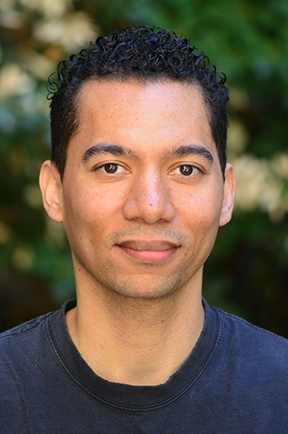
The UC Davis championship team was comprised of Ralph Washington Jr. and members Jessica Gillung, Brendon Boudinot and Ziad Khouri. All are graduate students in the UC Davis Department of Entomology and Nematology. They earlier won the Linnaean Games competition at the regional level: the Pacific Branch of ESA.
Washington is studying for his doctorate with major professors Steve Nadler and Brian Johnson, who respectively specialize in systematics and evolutionary biology of nematodes and the evolution, behavior, genetics, and health of honeybees; Boudinot with major professor Phil Ward, systematics and evolutionary biology of ants; and Jessica Gillung and Ziad Khouri with major professor Lynn Kimsey, who specializes in the biology and evolution of insects. Kimsey directs the Bohart Museum of Entomology.
Two members of the UC Davis Department of Entomology and Nematology faculty--Extension entomologist Larry Godfrey and Extension apiculturist Elina Niño--served as the team's advisors.
Here are some of the questions that the UC Davis team correctly answered:
Toss-Up Question: What is the smallest insect that is not a parasite or parasitoid?
Answer: Beetles in the family Ptiliidae.
Bonus Question: Some species of mosquitoes lay eggs that can undergo diapause or aestivation. Give at least three cues that trigger the aquatic eggs to hatch.
Answer: Temperature, immersion in water, concentration of ions or dissolved solutes.
Toss-Up Question: Chikungunya is an emerging vector-borne disease in the Americas. Chikungunya is derived from the African Language Makonde. What means Chikungunya in Makonde?
Answer: Bending up.
Toss-Up Question: A Gilson's gland can be found in what insect order?
Answer: Trichoptera
Toss-Up Question: Certain Chrysomelid larvae carry their feces as a defensive shield. To what subfamily do these beetles belong?
Answer: Cassidinae.
Bonus Question: The first lepidopteran sex pheromone identified was bombykol. What was the first dipteran sex pheromone identified? Give the trade or chemical name.
Answer: Muscalure, Z-9-Tricosene. It is also one of the chemicals released by bees during the waggle dance.
Toss-Up Question: What famous recessive gene was the first sex-linked mutation demonstrated in Drosophila by T.H. Morgan?
Answer: White
Bonus Question: Cecidomyiidae are known as the gall flies. What is unique about the species Mayetiola destructor, and what is its common name?
Answer: Mayetiola destructor is the Hessian Fly, a tremendous pest of wheat. It does not form galls.
Toss-Up Question: Nicrophorus americanus is listed under what legislative act?
Answer: The Endangered Species Act
Toss-Up Question: In what insect order would you find hemelytra?
Answer: The order Hemiptera.
Toss-Up Question: The subimago stage is characteristic of what insect order?
Answer: The order Ephemeroptera
Bonus Question: A 2006 Science article by Glenner et al. on the origin of insects summarized evidence that Hexapods are nothing more than land-dwelling crustaceans, which is to say that the former group Crustacea is paraphyletic with respect to the Hexapoda. What hierarchical name has been used to refer to this clade?
Answer: Pancrustacea
Toss-Up Question: What are the three primary conditions that define eusociality?
Answer: Cooperative brood care, overlapping generations, and reproductive division of labor
A total of 10 teams competed in the 2015 Linnaean Games:
- Eastern Branch: Virginia Tech University and University of Maryland
- North Central Branch: Michigan State University and Purdue University
- Pacific Branch: UC Davis and Washington State University
- Southeastern Branch: University of Georgia and University of Florida
- Southwestern Branch: Oklahoma State University and Texas A&M
The UC Davis Linnaean Games Team won the championship--they're the stars--but congratulations to all! It's a honor to be selected on a team and an honor to win a spot at the regionals and advance to the nationals.

- Author: Kathy Keatley Garvey

The honey bee guru continues to answer a range of questions. The latest concerns the effect of marijuana growing sites on honey bees.
We thought we'd share his answer, which deals with honey bees, pollinators, Cannabis, pesticides, and what could happen to beekeepers who stumble upon a pot farm.
The question: "What is the effect, good or bad, that marijuana plants and marijuana grow sites have on the honey bee? From what I understand, these grow sites are using chemicals to control pests year round. In some cases, I hear that marijuana growers are importing chemicals from Mexico that are stronger and work better to control pest."
Mussen answered the question succinctly and openly.
"As you might guess, since marijuana is still considered an illegal plant to grow by the federal government," he replied, "it is no surprise that there are no pesticides registered for use on the 'crop.' Some states are trying hard to build a list of acceptable products, but here is the problem. So far we have registered products based on contact and oral toxicities to mammals. We have only run inhalation toxicities on a few very potent and stinky products (fumigants). You can get up to 10X the dose of a chemical, from the same amount of plant mass, if you smoke it versus eating it.
"There are quite a number of websites dedicated to pot growing. When pest control becomes the topic, most sites suggest mechanical methods or use of products allowed in organic agriculture. However, those organic pesticides have not been checked for inhalation effects, either."
"Thus, practically any pesticide that is used will be illegal. Given that, growers are apt to determine which materials work best on the pest at hand on other crops, acquire those materials, and use them. The regulators know this, and in states where marijuana currently is legal, the states are testing some of the products on the shelves to see what pesticides are in them. The samples have been found to be pretty clean, for the most part."
Mussen acknowledged that blooming hemp plants are attractive to many pollinators. "I have no idea what the pollen and nectar might do to them when the bees consume it. We can provide a pretty good idea of what will happen when pesticide products used on other crops are applied to the bloom (at agricultural rates), but since nothing is registered, there is no way of guessing what might be used. For the standard fee of just under $400, we can send a sample of the bees or pollen to the USDA AMS pesticide residue detection lab in Gastonia, N.C., and they can tell us the residues. Butthat doesn't help us much in terms of regulatory assistance.
"Pot growers probably won't care if they repel or kill visiting bees," Mussen speculated. "Pollinated blossoms become senescent too quickly, and do not produce the maximum amount of important resins if they are pollinated early in their cycle."
"Up to this time, I have not heard of beekeepers reporting damage from pesticides applied to marijuana, but it is likely to happen before long. Beekeepers are more worried about being shot if they accidentally get too close to a pot farm."
Stay tuned.
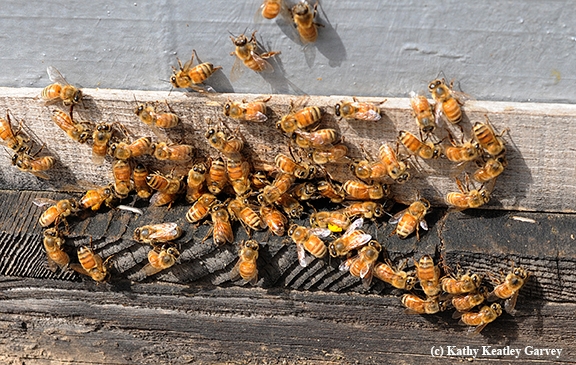
- Author: Kathy Keatley Garvey
Counting butterflies before they eclose from their chrysalids is sort of like counting chickens before they hatch.
We've done both: raised chickens and reared butterflies.
Fact is, you never know if a butterfly will eclose. The old adage of "Don't count your chickens before they hatch" rings true, as does "Don't count your butterflies before they eclose."
We've reared and released a total of 20 monarch butterflies this year in Vacaville, Calif. It's a small conservation effort, true, but what a difference it's made for those 20 monarchs! Now three chrysalids remain. Unlike the others, all three chrysalids are outdoor chrysalids. Two are hanging in an aquarium setting and look viable. One is tucked inside a zippered mesh laundry hamper and shows no sign of life or pending life.
The "no-sign-of-life" chrysalis turned from jade green to black on Nov. 15. Aha, we thought. We'll get a butterfly within 48 hours. That was the case with our indoor chrysalids once they darkened. (Note that a chrysalis looks like a gold-studded green jewel for about 10 days before it darkens. Then the monarch ecloses and hangs onto the transparent pupal case until it unfolds and dries its wings.)
This time nothing happened. We could clearly see the wing pigment. Hello, you in there! Time's up! Are you coming out or what?
Hmm, we thought. Maybe this is a "what." Cold weather delaying the eclosure? The "P" word--parasitized? The "D" word--diseased or dead?
So we contacted butterfly guru Art Shapiro, distinguished professor of evolution and ecology at the University of California, Davis. He's been monitoring butterfly populations in central California for more than 40 decades (see his website). He's the author of Field Guide to Butterflies of the San Francisco Bay and Sacramento Valley Regions (California Natural History Guides), a book, by the way, that's available in the Bohart Museum of Entomology gift shop on campus as well online.
It's not parasitized, he said, or it would not have developed the wing pigment.
Then Shapiro's keen eyes detected this: "On the dorsal surface there is a kink in the integument and there is a lot of intersegmental membrane showing. I think your beast developed to the pharate adult and died uneclosed--three weeks ago."
He recommends we keep it hanging for a few more days to see what happens. "The integument should fall off and you can inspect the pharate cadaver!"
Well, let's see. One down and two to go and then it's all over until next year.
Oh, wait, don't count your monarchs before they eclose...


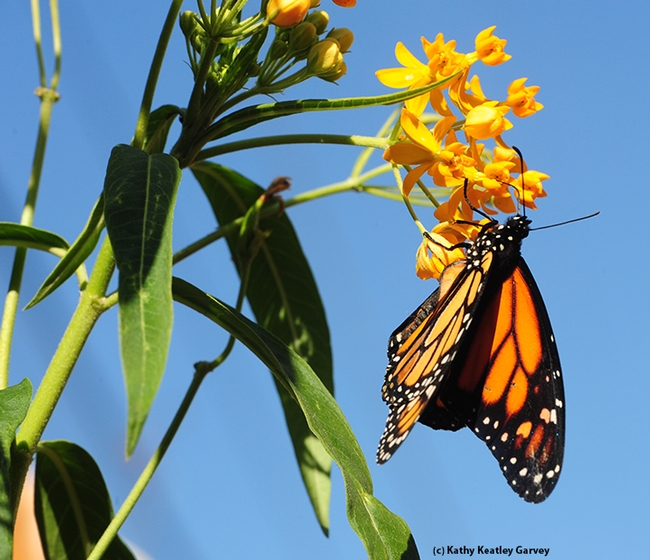
- Author: Kathy Keatley Garvey
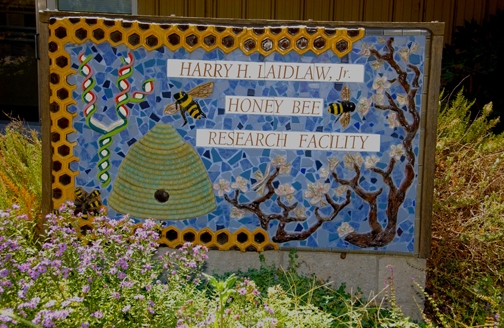
Bee scientists at the Harry H. Laidlaw Jr. Honey Bee Research Facility at the University of California, Davis, are offering a total of four short courses from Feb. 13 to March 20. All will be at the Laidlaw facility, located on Bee Biology Road, west of the central campus. They will be comprised of lectures in the conference room and hands-on exercises in the apiary.
Instructors are Extension apiculturist Elina Lastro Niño; staff research associate Bernardo Niño; facility manager/staff research associate Charley Nye; and graduate student Tricia Bohls.
The first short course, "Planning Ahead for Your First Hives," is set Saturday, Feb. 13. "This is perfect for those who have little or no beekeeping experience and would like to obtain more knowledge and practical skills to move on to the next step of owning and caring for bees," says Elina Niño. You'll learn about honey bee biology, beekeeping equipment, how to start your colony, and maladies of the hive. You'll be shown how to install a package, how to inspect your hive and how to monitor for those dreaded varroa mites. The $95 registration fee covers the cost of course materials (including a hive tool), lunch, and refreshments
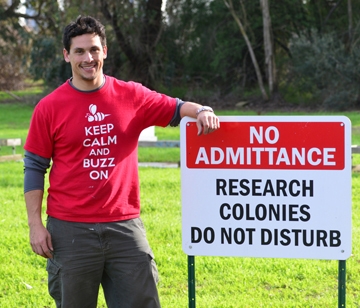
Next will be the "Queen Rearing Techniques" short course. Due to popular demand, there will be two sessions and you can select the one on Saturday and Sunday, March 12-13 or the one the following weekend, on Saturday and Sunday, March 19-20. You'll learn about honey bee queen biology, basics of selective honey bee breeding programs, various queen-rearing techniques, testing hygienic behavior, and assessing varroa mite levels. You'll have the opportunity to learn about and practice multiple methods for queen rearing.
“We will go through a step-by-step process for queen rearing via grafting, including setting up cell builders and mating nucs,” Elina Niño said. At the end of the course, you'll be able to check your grafting success. If you live in the area, you can take home queen cells from the workshop. You'll also learn techniques to assess varroa mite loads and to evaluate hygienic behavior. Each session also will include a guided tour of the adjacent Häagen-Dazs Honey Bee Haven, a half-acre bee friendly garden that attracts many pollinators and is filled with art from the UC Davis Art/Science Fusion Program and entomology/art classes taught by Diane Ullman and Donna Billick.
The $350 registration fee for each queen-rearing session covers the cost of course materials (including a set of grafting equipment: grafting frame with bars, plastic queen cups and a grafting tool), breakfast, lunch and refreshments on the days of the short course.
Interested? For more information, contact Bernardo Niño at elninobeelab@gmail.com or call (530) 380-BUZZ (2899). The Niño lab website is at http://elninobeelab.ucdavis.edu/, and the Facebook page at https://www.facebook.com/elninolab/. The bi-monthly apiculture newsletter, written by Elina Niño, is online.
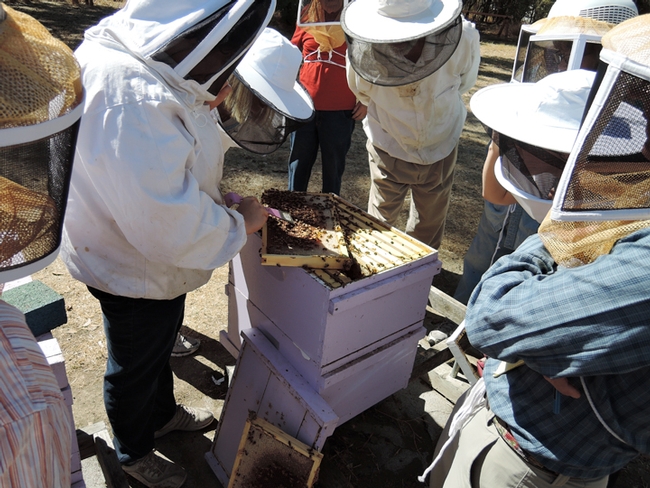

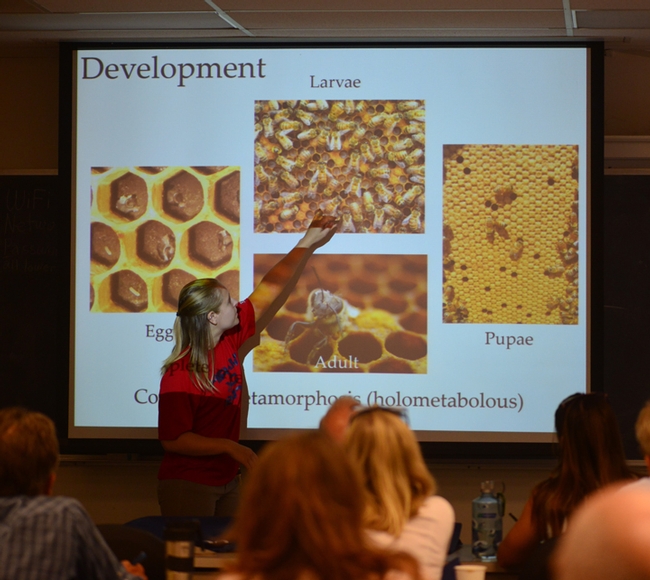
- Author: Kathy Keatley Garvey

Their colleague Anna Davidson, who recently received her doctorate at UC Davis in the Department of Plant Sciences and is now studying for her master of fine arts degree, organizes the UC Davis LASER events.
She's the person behind the scenes--and in front of the podium--who provides the speakers.
Her next event is from 7 to 9 p.m., Tuesday, Dec. 1 in Room 3001 of the Plant and Environmental Sciences Building. What a program she's lined up! Four speakers who fuse art with science will present 20-minute talks on several disciplines, including medicine, visual art and astrophysics.
The event is free and open to the public.
7 to 7:25 p.m.: Robert Lang, a scientist and artist known as one of the world's foremost origami artists, will speak on “From Flapping Birds to Space Telescopes: The Art and Science of Origami”
7:25 to 7:50 p.m.: Charlotte Jacobs, emeritus professor/physician at Stanford University who currently cares for cancer patients at the Palo Alto Veterans' Medical Center, will speak on "Jonas Salk and the Conquest of Polio.” She wrote a newly published biography on Jonas Salk (Jonas Salk: A Life), which, she says eradicated the crippling disease, but the scientific community never forgave him.
8:10-8:35 p.m.: Rachel Clarke, artist and educator teaching new media art at California State University, Sacramento, will cover “Merging Spaces,” about her latest art work, which combines physical and virtual modes of making
8:35-9 p.m.: Andreas Albrecht, professor and chair of the UC Davis Department of Physics, will discuss “What Is Time?” He is a leading theoretical physicist who specializes in understanding the origins of the universe will be talking about “time.”
More about Jacobs: She is the Ben and A. Jess Shenson Professor of Medicine (emeritus) at Stanford University. A native of Kingsport, Tenn., she studied medicine at Washington University, St. Louis. As a professor at Stanford University, she engaged in teaching, cancer research, and patient care. She received numerous awards for excellence in patient care and teaching, as well as the Distinguished Alumni Award from Washington University.
In his origami talk, Lang says he will discuss the techniques used in mathematical origami design, which range from the abstruse to the highly approachable. “I will describe the geometric concepts led to the solution of a broad class of origami folding problems – specifically, the problem of efficiently folding a shape with an arbitrary number and arrangement of flaps.” Lang holds a doctorate in applied physics from California Institute of Technology (Caltech), and during his work at NASA/Jet Propulsion Laboratory, Spectra Diode Laboratories, and JDS Uniphase, authored or co-authored more than 100 papers and 50 patents in lasers and optoelectronics as well as authoring, co-authoring, or editing 14 books and a CD-ROM on origami.
Clarke, whose topic is new media art, says her work combines physical and virtual modes of making. “As a comment on extreme consumerism in our contemporary lifestyle, the ephemeral works I create are often comprised of the waste products of that lifestyle – banal junk such as food packaging, advertising mailers, plastic bags – as well as discarded digital information. Through physical and digital processes, the discarded materials become contemplative artworks, in the form of experimental animations, augmented reality sculptures, and installations. While I'm using the technologies developed for 21st century capitalism, the way I'm using them becomes a critique of the corporate model of technology – a model designed for consumption of media, not creativity.”
Professor Albrecht says that “Time is a central part of everyday life, yet it can still seem very mysterious.” He will discuss time from a physicist's point of view “in a way that takes us from every day experiences to deep questions about the cosmos.” He is a member of the new Center for Quantum Mathematics and Physics at UC Davis.
In some of the previous UC Davis LASER events, speakers zeroed in on insects. There's an insect connection with the Dec. 1 event, too. Salk is often quoted as saying "If all the insects were to disappear from the Earth, within fifty years all life on Earth would end. If all human beings disappeared from the Earth, within fifty years all forms of life would flourish."
Did Salk say that? Probably not. No more than Albert Einstein said "If the bee disappeared off the surface of the globe, then man would have only four years of life left. No more bees, no more pollination, no more plants, no more animals, no more man.”
Related Links:
For more information on the program, see
https://www.facebook.com/events/1732840033613610/
For directions to the Plant and Environmental Sciences Building, see
http://www.plantsciences.ucdavis.edu/plantsciences/visitors/map.htm
Contact information:
Anna Davidson, adavidson@ucdavis.edu



